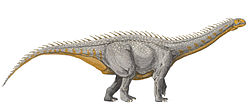| Losillasaurus Temporal range: Late Jurassic, | |
|---|---|
 | |
| L. giganteus vertebra | |
| Scientific classification | |
| Kingdom: | Animalia |
| Phylum: | Chordata |
| Class: | Reptilia |
| Clade: | Dinosauria |
| Clade: | Saurischia |
| Clade: | † Sauropodomorpha |
| Clade: | † Sauropoda |
| Clade: | † Turiasauria |
| Genus: | † Losillasaurus Casanovas et al., 2001 |
| Species: | †L. giganteus |
| Binomial name | |
| †Losillasaurus giganteus Casanovas et al., 2001 | |
Losillasaurus (meaning "Losilla lizard") is a genus of turiasaurian sauropod dinosaur from the Late Jurassic and possibly Early Cretaceous (Kimmeridgian-?Berriasian) of southeastern Spain. The type species, Losillasaurus giganteus, was discovered in the Villar del Arzobispo Formation in Valencia, and formally described by Casanovas, Santafé, and Sanz in 2001. The holotype material is from a subadult and includes part of a skull; complete cervical, dorsal, sacral, and caudal vertebrae as well as several fragments; skeletal elements from the limbs including a humerus, ulna, radius, and metacarpal; sternal plates; and from the pelvis: the ilium, ischium, and pubis. The genus is characterized by the dimension and shape of the neural spine of the proximal caudal vertebrae. [1] [2] The humerus is 143 centimetres (56 in) long, [3] which despite being from a subadult specimen is within 20% of the size of Paralititan . [4] The size estimation proposed by Francisco Gascó in his master thesis is 15–18 m (49–59 ft) in length and 12–15 t (13–17 short tons) in body mass. [5]












